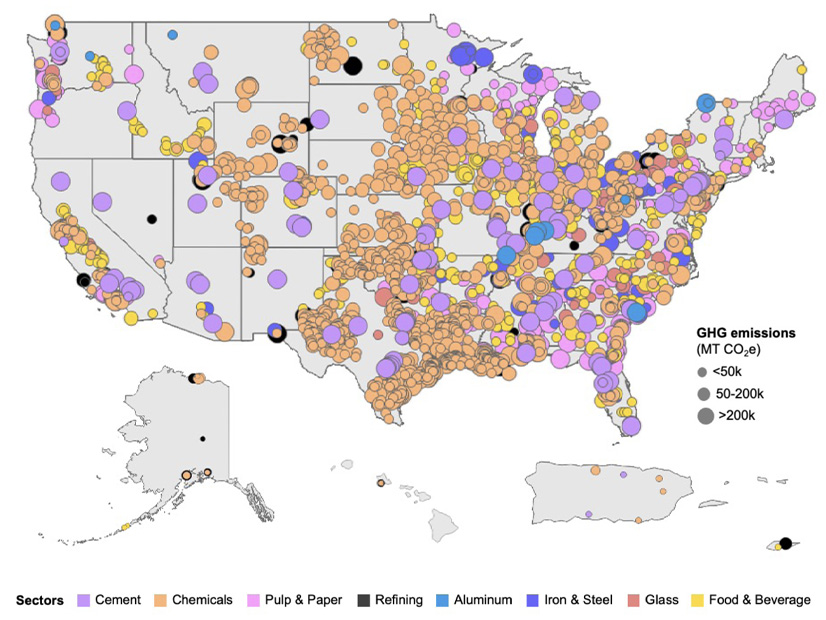
The agency's three “Pathways to Commercial Liftoff” reports focus on the challenges of industrial decarbonization.
The U.S. Department of Energy on Monday released three “Pathways to Commercial Liftoff” reports focused on industrial decarbonization.
One report is focused broadly on industrial decarbonization, addressing chemicals, refining, iron and steel, food and beverage, cement, pulp and paper, aluminum and glass.
The other two focus on specifically cutting emissions in cement production and the chemicals and refining industries.
“This administration is committed to engaging with our private sector partners to accelerate the commercialization and deployment of key technologies needed to achieve the President’s ambitious climate and decarbonization goals,” Energy Secretary Jennifer Granholm said in a statement. “The reports released today provide in-depth analysis of emerging technologies and clear benchmarks to help guide targeted investments and propel the U.S. toward our clean energy future.”
Decarbonization presents an opportunity to transform industrial systems to improve energy and environmental justice, DOE said. Carbon-intensive industrial sectors are facing a critical inflection point, which offers a unique moment that neither the agency nor the private sector can allow to pass, it said.
The industrial sector represents 23% of the nation’s total greenhouse gas emissions, but the specific industries make up 14% of those emissions. Chemicals and refining is by far the largest emitting sector, making up 7% of the total U.S. emissions.
“Reasons often cited for slow progress on the decarbonization of industrial emissions include: the immaturity and high cost of many decarbonization levers; unidentified or uncertain customer demand for low-carbon products; and, in some but not all sectors, reluctance among companies to be a first mover,” the report said.
Even if the electricity and transport sectors decarbonize in line with the administration’s targets, and only limited abatement occurs in the industrial sector, the share of industrial emissions could rise to 27% of the country’s total by 2030 — even with associated impacts from the use of electricity and transportation.
The Infrastructure Investment and Jobs Act and the Inflation Reduction Act both offered support for decarbonizing industry. Customers and other stakeholders increasingly expect companies to address climate change, and some industrial firms are starting to work on it.
“Willing U.S. industry participants could utilize the momentum of the present moment to accelerate the commercialization of decarbonization technologies, respond to rising global demand for clean industrial commodities and establish the U.S. as a global leader in industrial decarbonization,” the report said.
The report found that up to 30-40% of the emissions across the eight sectors could be addressed by 2030 using techniques that have net positive economics (when federal incentives are factored in), alongside emissions reductions from external factors such as cleaner grid power and transportation.
Ready-to-go decarbonization techniques include energy management systems/efficiency, carbon capture and storage (CCS) for natural gas processing, and other industry-specific changes.
“Expanding beyond near-term thinking and fully decarbonizing industry will be extremely challenging without cost reductions, education, breakthroughs, a complementary skilled workforce and widespread public acceptance,” the report said.
Another tranche of decarbonization would require some funding to bring demonstration-level technologies to the mainstream, such as industrial CCS retrofits, clean onsite electricity and storage and using heat pumps to electrify pulp and paper manufacturing.
However, to fully decarbonize all the industrial sectors in the report, some technologies that are in the research and development or pilot phases will need to mature. Those include alternative chemistries to make cement and using captured carbon for industrial purposes.
The report estimates that fully decarbonizing the sectors it studied would cost between $700 billion and $1.1 trillion by 2050.
“To achieve adoption at scale of deployable technology levers will require bold leadership, even for solutions with net-positive economics,” the report said. “One factor is that, across the sectors of focus, many companies face pressure to plan towards and achieve near-term earnings targets.”
The report noted that environmental, social and governance (ESG) investing has been on the rise, which, along with “patient” capital, has somewhat alleviated that pressure, but the short-term focus on quarterly profits can still affect decision-making when it comes to making decisions on how to use long-term infrastructure investments.



